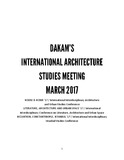| dc.description.abstract | The paper is an attempt to approach the imaginary dimension of ‘making a home’ in the urban periphery; in sites
that are still under construction, in places whose character is still undefined and fleeting. ‘Making a home’ is
understood as the set of spatial, social and cultural practices that shape everyday domestic spaces, on a personal and
collective level, and also as a field where psychological processes, imaginary identifications and ideological
formulations meet.
The study discusses the depiction of suburban houses in Greek films produced during the 1950-1960’s, a period
during which the growth of post-war Greek cinema coincided with the development of the post-war Greek city. It
traces the imagery of suburban houses in four Greek popular films from a time when the film production industry
was only superseded by the building frenzy that completely transformed Greek urban (and suburban) space after
WWII.
Starting from descriptions of the films’ spatial iconography, the paper examines the activities associated with
them and suggests a composite reading of the two –the representations of space and the actions connected to themas
a way to bring to the fore the social and cultural relationships that shape spatial structures and are in turn shaped
by them. The building of the imaginary is ‘read’ in the films’ imaginary buildings: in plans structured through
scenography and montage, in spatial continuities and discontinuities shaped with movement and stasis, in personally
and collectively private places bounded by words and moving pictures.
The paper is an attempt to approach the imaginary dimension of ‘making a home’ in the urban periphery; in sites
that are still under construction, in places whose character is still undefined and fleeting. ‘Making a home’ is
understood as the set of spatial, social and cultural practices that shape everyday domestic spaces, on a personal and
collective level, and also as a field where psychological processes, imaginary identifications and ideological
formulations meet. Considering cinema as a constructed reflection of widespread ideas and concepts about social,
cultural and spatial relationships, the paper examines the spatial iconography of the upper-class residence in order
to locate the spatial elements that shape it and discern the most constant threads within a variety of filmic textures.
The concept of the Imaginary order was used by J. Lacan (Miller, 1978) in order to describe the stage before the
acquisition of language in the development of a person as a subject. The Imaginary is the space of images (visual and
mental) and primary identifications that are based on images, and on notions of coherence rather than
fragmentation. The Imaginary order is directly associated with the Mirror Stage, and the ways that an infant relates
to its own and to others’ reflections. The formation of the subject through images is then connected to a double
contradiction: the body that the infant feels as fragmented is reflected as a coherent whole, and at the same time
this coherent whole is an imperfect I next to an idealized Other (e.g. the body of the mother). Both contradictions
establish a lack: the shortcomings of one’s self compared to the perfections of others.
C. Castoriadis (Castoriadis, 1978) has set the imaginary at the foundation of human creativity and social
differentiation, tracing all social constructions back to it: rules, institutions, ideas, and systems of values and
objectives that are based on collectively accepted indisputable truths. The imaginary is where all forms of authority
base their strength, either explicit (like political authority) or implicit (essentially, the power of the imaginary itself to
set the rules, an institutive authority). It is what shapes the field of significations on which any society is based, and
as such, it intersects with L. Althusser’s concept of ideology (Althusser, 2007). Understood as the way in which people
experience and comprehend their relationship to the conditions of their existence, Althusser’s concept of ideology
weaves together what is real and what is imaginary on a spider’s web of representational systems. Beliefs and actionsstem from these systems that despite their power remain unspoken. Ideology helps to naturalize relationships and
effortlessly legitimize social constructions, by confirming them over and over every day. As Y. Athanasatou notes,
“That which comes out, which is ‘made’ in ideology is the unity of real and imaginary relationships between people
and the actual conditions of their existence.” (Athanasatou, 1999, pp. 43-44). | en_UK |


